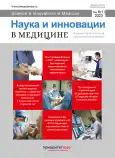Клинико-диагностическое значение ингибитора активатора плазминогена 1 типа в раннем развитии ишемической болезни сердца
- Авторы: Нуриллаева Н.М.1, Хасановa Н.А.1, Зокирова М.Б.1
-
Учреждения:
- Ташкентская медицинская академия
- Выпуск: Том 8, № 1 (2023)
- Страницы: 34-38
- Раздел: Кардиология
- URL: https://bakhtiniada.ru/2500-1388/article/view/131497
- DOI: https://doi.org/10.35693/2500-1388-2023-8-1-34-38
- ID: 131497
Цитировать
Полный текст
Аннотация
Цель – выявить количественное содержание ингибитора тканевого активатора плазминогена 1 типа (PAI-1) и определить его связь с факторами риска ИБС.
Материал и методы. В исследование было включено 67 пациентов мужского и женского пола (36 мужчин и 31 женщина) с ИБС и ССН II–IV функционального классов (ФК) на фоне АГ. Средний возраст больных составил 60,2±0,76 года. У всех пациентов были собраны клинико-анамнестические данные при осмотре, определены оценка боли по вербальной шкале, антропометрические данные и индекс массы тела, назначены биохимические и инструментальные методы исследования согласно стандартам диагностики ИБС. Проведена оценка встречаемости факторов риска пациентов, включенных в исследование. Выполнен комплекс общеклинических лабораторно-инструментальных исследований, а также применен метод иммуноферментного анализа (ИФА), определяющий количество PAI-1 (ингибитор активатора плазминогена-1), агрегационная активность тромбоцитов, ренин, альдостерон, кортизол и эндотелин.
Результаты. Выявлено достоверное увеличение плазменного PAI-1 в группе больных. По сравнению с практически здоровыми людьми количество этого биомаркера было в 1,6 раза выше у больных ИБС. Значительное увеличение количества PAI-1 свидетельствует о повышенном риске эндотелиальных и гемостазиологических нарушений у пациентов, что повышает риск развития тромбогенных осложнений. Обнаружено, что белок PAI-1 при ИБС в плазме крови коррелировал с такими факторами риска, как ТДС, курение, АГ, ожирение и гиперхолестеринемия.
Ключевые слова
Полный текст
Открыть статью на сайте журналаОб авторах
Наргиза Мухтархановна Нуриллаева
Ташкентская медицинская академия
Автор, ответственный за переписку.
Email: nargizanur@yandex.ru
ORCID iD: 0000-0001-5520-675X
д-р мед. наук, профессор, заведующая кафедрой внутренних болезней №1
Узбекистан, ТашкентНаргиза Абдумухтаровна Хасановa
Ташкентская медицинская академия
Email: xasanova_nargiza@bk.ru
ORCID iD: 0000-0003-0156-1304
ассистент кафедры внутренних болезней №1
Узбекистан, ТашкентМуборакхон Бобуровна Зокирова
Ташкентская медицинская академия
Email: muborakhonk@gmail.com
ORCID iD: 0000-0002-7455-3869
ассистент кафедры внутренних болезней №1
Узбекистан, ТашкентСписок литературы
- Katrancıoğlu N, Karahan O, Kurtulgan H, et. al. PAI-1 4G/4G gene polymorphism is associated with higher serum lipid level in Turkish population. Cumhuriyet Medical Journal. 2011;33(3):307-311.
- Assawamakin A, Sriratanaviriyakul N, Lalerd Y, et al. Meta-analysis of the plasminogen activator inhibitor-1 (PAI-1) gene with insertion/deletion 4G/5G polymorphism and its susceptibility to ischemic stroke in Thai population. Asian Biomedicine. 2017;6(2):203-217. doi: 10.5372/1905-7415.0602.047
- Jing-Ren Jeng, Horng-Jyh Harn, Kuo-Cheu Yueh, et al. Plasminogen Activator Inhibitor-1 and Angiotensin I Converting Enzyme Gene Polymorphism in Patients With Hypertension. Am J Hypertens. 1998;11(2):235-239. doi: 10.1016/S0895-7061(97)00476-7
- Festa A, D’Agostino RJ, Rich SS, et al. Promoter (4G/5G) Plasminogen Activator Inhibitor-1 Genotype and Plasminogen Activator Inhibitor-1 Levels in Blacks, Hispanics, and Non-Hispanic Whites. Circulation. 2003;107:2422-2427. doi: 10.1161/01.CIR.0000066908.82782.3A
- Srikumar N, Brown NJ, Hopkins PN, et al. PAI-1 in human hypertension: relation to hypertensive groups. Am J Hypertens. 2002;15(8):683-90. doi: 10.1016/s0895-7061(02)02952-7
- Asamov RE, Magrupov BA, Vervekina TA, et al. Prevalence rate of fatal and nonfatal pulmonary artery thromboembolism at a multimodality hospital. Angiology and vascular surgery. 2011;17(3):21-24. (In Russ.). [Асамов Р.Э., Магрупов Б.А., Вервекина Т.А., и др. Частота фатальной и нефатальной тромбоэмболии легочной артерии в многопрофильном стационаре. Ангиология и сосудистая хирургия. 2011;17(3):21-24].
- Khasanova NA, Nurillaeva NM. The value of plasminogen activation inhibitor (PAI 1) in the development of cardiovascular diseases. Ўзбекистон Кардиологияси. 2019;3(53):98-104. (In Russ.). [Хасанова Н.А., Нуриллаева Н.М. Значение ингибитора активатора плазминогена (PAI 1) в развитии сердечно-сосудистых заболеваний. Кардиология Узбекистана. 2019;3(53):98-104].
- Li P, Schmidt IM, Sabbisetti V, et al. Plasma Endothelin-1 and Risk of Death and Hospitalization in Patients Undergoing Maintenance Hemodialysis. Clin J Am Soc Nephrol. 2020;15(6):784-793. doi: 10.2215/CJN.11130919
- Sandrini L, Ieraci A, Amadio P, et al. Impact of Acute and Chronic Stress on Thrombosis in Healthy Individuals and Cardiovascular Disease Patients. Int J Mol Sci. 2020;21(21):7818. doi: 10.3390/ijms21217818
- Hannibal KE, Mark D. Bishop, Chronic Stress, Cortisol Dysfunction, and Pain: A Psychoneuroendocrine Rationale for Stress Management in Pain Rehabilitation. Physical Therapy. 2014;94(12):1816-1825. doi: 10.2522/ptj.20130597
- Gabriele M, Veronesi L, Maccieri J, et al. Plasma Renin Concentration in Critically Ill COVID-19 Patients. BioMed. 2021;2: 94-98. doi: 10.3390/biomed1020008
- Nevzorova VA, Nastradin OV, Rodionova LV, Suleimanova ES. Serum levels of sexual hormones in young and middle-age healthy subjects with risk factors of coronary heart disease and patients with coronary heart disease. Therapeutic archive. 2005;77(9):28-31. (In Russ.). [Невзорова В.А., Настрадин О.В., Родионова Л.В., Сулейманова Е.С. Содержание половых гормонов в сыворотке крови у здоровых с факторами риска развития ишемической болезни сердца и больных ишемической болезнью сердца молодого и среднего возраста. Терапевтический архив. 2005;77(9):28-31].
Дополнительные файлы






